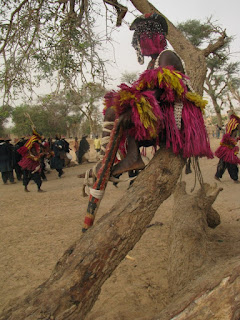

Sangha, Ireli, Yaye, Tireli, Pegde, Banani, Amani -- names that evoke images of powder soft dust, splashes of vivid pink and purple and black dancing and jumping and twirling bodies, frightening masks and bundles of fetishes dangling, stone houses and mud granaries, women stamping corn, crocodile totems, baobab rope and elusive stars, tortoises that tell the future, cemeteries in cliffs, sleeping on rooftops, walking up mountains, trekking through the groves of baobabs, asking the jackal to give answers to your questions, hauling water out of a well, reading history on carved doors, watching donkeys and goats drink from the croc pool, cow masks, ten metre high masks, old men chewing kola nuts, climbing climbing climbing to the sky, drinking millet cream, shells and beads and bronze, eating mangoes, goats butting heads and eagles soaring, graceful women carrying loads on their heads, cows pulling plows, old men talking and young boys dancing
The Dogon Country is magical and mysterious -- wedged between the encroaching desert plains and the towering cliffs of the escarpment. the earlier ancient Telem tribes's round houses are lodged in between the rocks high up where the eagles live, the later Dogon tribes' mud covered houses and granaries built lower down, all masterfully camouflaged to keep them safe and secure against the onslaught of the modern world. Each village has a market on a given day -- and that day is called after the village -- so Monday is Tereli, Tuesday is Yaye and so on -- a five day week in the Dogons. Each village is home to certain families -- as it has always been and as it will be for all time. Each village has a totem -- the animal that led them to that place originally, showed them where to find the water and still protects them against bad spirits. I cannot help but wonder about the crocodiles that live in the pond of Amani. The animals come to drink, the children come to fetch water, and never ever has a crocodile attacked anyone from Amani. Beware strangers, though. If you are not from this village, the crocodiles will eat you. I am sceptical about this -- these are big and mean looking crocs. But our guide assures us they have never attacked anyone from Amani -- their own village and I have to believe him. In Erili the old woman shows us under the large rock where the tortoise lives - the tortoise that brought the people from Erili here back in the 14th century when they arrived in the Dogons. Is the tortoise really 600 years old? In the Dogons anything is possible.
In Terili the village honours us with a masked dance -- fifty or more young men come running from up high in the village down into the flat dusty area under the baobab trees at the bottom where the well is. The elders are dressed in their indigo cotton robes and Fulani hats and look on -- two of them take the drums from the younger men and start beating a rhythm - the mask dance master gives the signals to them and they change the rhythm to tell the different masked dancers which have to come up and perform. Each dance reflects the mask -- the hunter and the sable antelope perform a slower copy of the hunt - hunter and prey circling each other gracefully. There are dancers on high stilts, balancing not only themselves but their elaborate masks as well. The four young men with the ten metre high towers above them come forward and dances wildly, throwing their heads forward to have the tips of the masks almost touch at the front in the dust, then at the back -- their neck muscles straining taut under the enormous stress of the weight of these heavy wooden structures. One young man accidentally allows his mask to touch the ground behind him. As quick as a flash almost all the masked dancers surround him and then, as quickly disperse again and as if by magic, the offending culprit has disappeared -- no one knows, nor will ever know, which dancer had committed this faux pas.
The women of the village stay at a distance -- they are not allowed near the masks; this is men's business. At the end of the performance, a group of the dancers run at where the women are, and women run off screaming. The children think it is the best thing they have experienced -- since the last time they had the pleasure of being part of this age-old tradition.
Later that evening we all talk about our favourite masks and which one we would like to have. We look in the little shop at the many different and beautiful masks available. My favourite was of course the cow mask -- but no one has one for sale like the one that had been sued in the ceremony. Much later, as we are sitting chatting under the stars and over a glass of hathe , I express my disappointment that I cannot have the mask that was used in the dance. Suddenly, there stands a young man with the mask in his hands. It is mine - at a price. A fifty-year family heirloom that will have to be replaced pretty niftily before the next masked dance - but I had expressed my wish to have the mask, and the mask is mine. My cow goes with me down the Wrest Coast of Africa...

































No comments:
Post a Comment